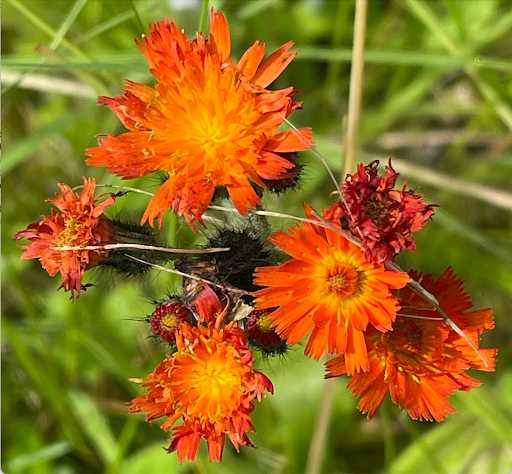
(Photo by Olivia Schmidt/KFSK)
A visually striking but ecologically devastating plant is spreading through Southeast Alaska: the orange hawkweed.
As you drive past the ditches orange hawkweed calls home, you might not even register that it’s there. The flame-colored blooms seem like any other wildflower popping out of the ground in spring and summertime. But don’t be fooled by its beauty; this weed is an aggressive invader.
Petersburg plant enthusiast Mary Clemens described the plant as: six to 14 inches tall, usually on a single stem, with a bright orange flower — usually with multiple flower heads. “The stem, if you look at it closely, is usually very wooly or hairy,” said Clemens. “Most of the leaves grow near the ground, not on the stem.”
Clemens first saw it on a popular bike path north of town 30 years ago.
“I think it came from Olson’s Landing — some logging activities there,” Clemens said. “But it’s very possible that it’s had more than one place of entrance into our community. It has gradually spread up to town – and now it’s everywhere.”
The plant’s scientific name is Hieracium aurantiacum. It’s known as fox and cubs, missionary weed, or devil’s paintbrush. It was first brought to America from Europe in the early 1800s for use in ornamental gardens, but it has since slipped through the fences, and is now found in meadows, forests, pastures, and roadsides in almost every U.S. state. The first Alaskan Hawkweeds were allegedly planted in Juneau during the 1950s, and have since spread through many communities in Southeast, including Petersburg.
“The plant does like well-drained soils and sunshine, and so that’s a real concern here,” said Joni Johnson, an Invasive Species and Pesticide Use coordinator for the U.S. Forest Service. “In the late 2000s, I was definitely aware of orange hawkweed, you would see it in certain places — but it has spread significantly along the road shoulder. And not just the state highway, but onto National Forest system roads, and we’ve seen it move into disturbed young growth sites.”
The invasive plant’s spread is becoming a significant concern in areas across Southeast Alaska. The flower has even begun to take root in places it’s never been found before, including Alaska’s interior and the Southwest.
“Looking to south central Alaska where there’s also orange hawkweed, we’re seeing it move into subalpine and alpine habitat,” Johnson said. “Just in the last 10 years, we’re seeing it move out to the Aleutian Islands, which have ample amounts of well drained soil and full sunshine.”
Orange Hawkweed is outcompeting local plants for a few reasons: it spreads quickly, forming dense patches that outcompete native vegetation; it reproduces asexually through seeds, aboveground stems, and tiny underground roots called rhizomes, making it particularly prolific; and it releases chemicals that prevent plants from growing around it. Johnson calls them “plant bombs.
“As humans, we try to predict what the next ‘plant bomb’ is going to be, but it’s hard,” said Johnson. “For us in Alaska, by and large, we have been living in a place where our pristine habitats remain pristine. Orange hawkweed is one of those where it looks pretty and people in the community and elsewhere will refer to it as wildflowers — and they’re not wildflowers.”
However, there are a few things people can do to help curb the hawkweed invasion if they have an encounter in the wild:
“If people see it along trails, if it’s a single plant or two they should pull it, and bag it and throw it in the trash can.” Johnson advises. “They can also clip heads to prevent the spread of seeds, but these also have to be bagged and tossed.”
For larger areas, Johnson prescribes timed mowing and herbicides, followed up with reseeding the area with native plants to prevent reinfestation. She says the fight against Hawkweed in Petersburg may be a losing battle, but Southeast hasn’t lost the war. The public can help stop the spread of orange hawkweed and other invasive species by cleaning their vehicles, boots, and equipment after visiting infested areas, and choosing native species for gardens and lawns.
Johnson asks Southcentral-Southeast residents who spot hawkweed on Kupreanof Island, Point Agassiz, or anywhere else away from Mitkof Highway to report it to the Petersburg Ranger District.











